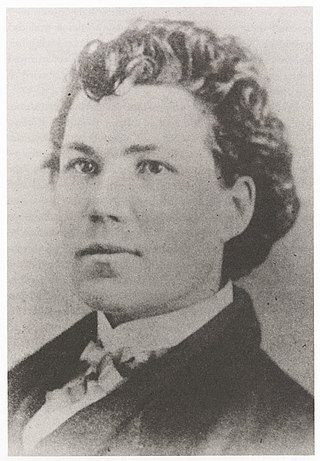Related Research Articles

Oliver Hazard Perry was a United States Navy officer from South Kingstown, Rhode Island. A prominent member of the Perry family naval dynasty, he was the son of Sarah Wallace Alexander and Captain Christopher Raymond Perry, and older brother of Commodore Matthew C. Perry.

Warren County is a county in the U.S. state of New York. As of the 2020 census, the population was 65,737. The county seat is Queensbury. The county was established in 1813 and is named in honor of General Joseph Warren, an American Revolutionary War hero of the Battle of Bunker Hill. The county is part of the Capital District region of the state.

Queensbury is a town in Warren County, New York, United States. The population was 29,169 at the 2020 census.

Joseph Eggleston Johnston was a Confederate military officer. He served in the United States Army during the Mexican–American War (1846–1848) and the Seminole Wars. After Virginia declared secession from the United States, he entered the Confederate States Army as one of its most senior general officers. From 1888 to 1889 he was a vice president, from 1889 to 1890 president, of the Aztec Club of 1847.

Sarah Emma Edmonds was a British North America-born woman who claimed to have served as a man with the Union Army as a nurse and spy during the American Civil War. Although recognized for her service by the United States government, some historians dispute the validity of her claims as some of the details are demonstrably false, contradictory, or uncorroborated.

Reuben Eaton Fenton was an American merchant and politician from New York. In the mid-19th century, he served as a U.S. Representative, a U.S. Senator, and as Governor of New York.

Reuben Wood was a Democratic politician from the U.S. state of Ohio. He served as the 21st governor of Ohio.

Benjamin Williams Crowninshield served as the United States Secretary of the Navy between 1815 and 1818, during the administrations of Presidents James Madison and James Monroe.

Edward Eggleston was an American historian and novelist.

Lake George, nicknamed the Queen of American Lakes, is a long, narrow oligotrophic lake located at the southeast base of the Adirondack Mountains, in the northeastern portion of the U.S. state of New York. It lies within the upper region of the Great Appalachian Valley and drains all the way northward into Lake Champlain and the St. Lawrence River drainage basin. The lake is situated along the historical natural (Amerindian) path between the valleys of the Hudson and St. Lawrence Rivers, and so lies on the direct land route between Albany, New York, and Montreal, Quebec, Canada. The lake extends about 32.2 mi (51.8 km) on a north–south axis, is 187 ft (57 m) deep, and ranges from one to three miles in width, presenting a significant barrier to east–west travel. Although the year-round population of the Lake George region is relatively small, the summertime population can swell to over 50,000 residents, many in the village of Lake George region at the southern end of the lake.

Lyman Copeland Draper was a librarian and historian who served as secretary for the State Historical Society of Wisconsin at Madison, Wisconsin. Draper also served as Superintendent of Public Instruction of Wisconsin from 1858 to 1860.

Reuben Locke Haskell was a U.S. Representative from New York.

Owl's Nest, also known as the Edward Eggleston Estate, is a historic estate property located on the shore of Lake George in Queensbury, New York. Developed in the 1870s and 1880s, it was the home of Edward Eggleston (1837-1902), one of America's first realist writers. He began summering there in the 1870s and it was his permanent home from the mid-1880s until his death. The property was declared a National Historic Landmark in 1971.

The family of Barack Obama, the 44th president of the United States, is a prominent American family active in law, education, activism and politics. Obama's immediate family circle was the first family of the United States from 2009 to 2017, and are the first such family of African-American descent. His immediate family includes his wife Michelle Obama and daughters Malia and Sasha.

East Lake George is a hamlet within the towns of Queensbury and Fort Ann in the U.S. state of New York. East Lake George attempted to incorporate as a village, a measure rejected by voters in 2010.
Events from the year 1858 in the United States.

Fort Ann is a town in Washington County, New York, United States. It is part of the Glens Falls Metropolitan Statistical Area. The town population was 5,812 at the 2020 census. The town contains a village, also called Fort Ann, located in its southeastern corner.
The 26th United States Colored Infantry, also called the 26th New York Infantry (Colored) was an African American infantry regiment, one of three colored troop units from the state of New York,1 that fought in the American Civil War. The unit was organized on Riker's Island in February 1864 by the Union League Club of New York.

Elizabeth Eggleston Seelye was an American writer and biographer. Her story "The A.O.I.B.R.", which appeared in Harper's Bazaar in 1889 with an illustration of a child reading, is cited by the Rockwell Centre for American Visual Studies as an early illustration of a girl reading. Allegra Eggleston and Rosina Emmet Sherwood provided illustrations for Seelye's stories.

Allegra Eggleston was a 19th-century American artist from the U.S. state of Minnesota. She occupied herself as a woodcarver, portrait painter, and book illustrator. As an illustrator, she collaborated with her sister, Elizabeth Eggleston Seelye, and her father, Edward Eggleston, on a number of books including The story of Columbus (1892), The story of Washington, and The Graysons.
References
- 1 2 3 New York State Historical Association 1921, p. 191.
- 1 2 3 4 New York State Historical Association 1921, pp. 191–92.
- ↑ "Elwyn Seeleye". The Ithaca Journal . October 21, 2020. p. 5. Retrieved January 7, 2020– via Newspapers.com.
- ↑ Foulke, Patricia; Foulke, Robert (November 1, 2014). "Joshua's Rock, Home of the Seelye-Eggleston Family" . Retrieved November 29, 2016.
Bibliography
- New York State Historical Association (1921). The Quarterly Journal of the New York State Historical Association (Public domain ed.). The Association.
Attribution
 This article incorporates text from this source, which is in the public domain : New York State Historical Association's The Quarterly Journal of the New York State Historical Association (1921)
This article incorporates text from this source, which is in the public domain : New York State Historical Association's The Quarterly Journal of the New York State Historical Association (1921)